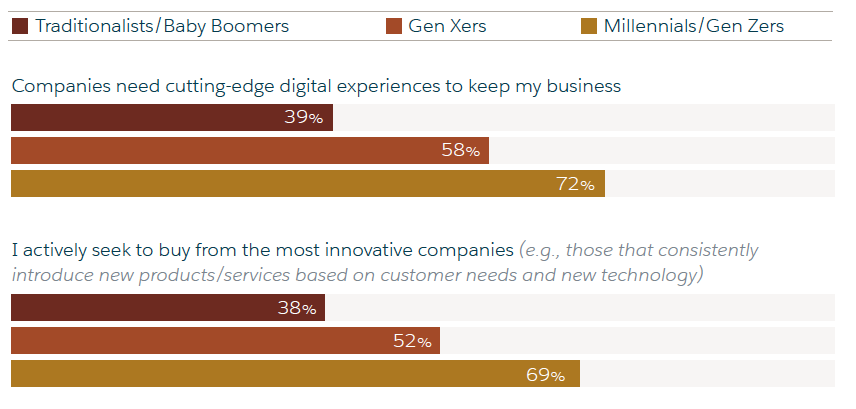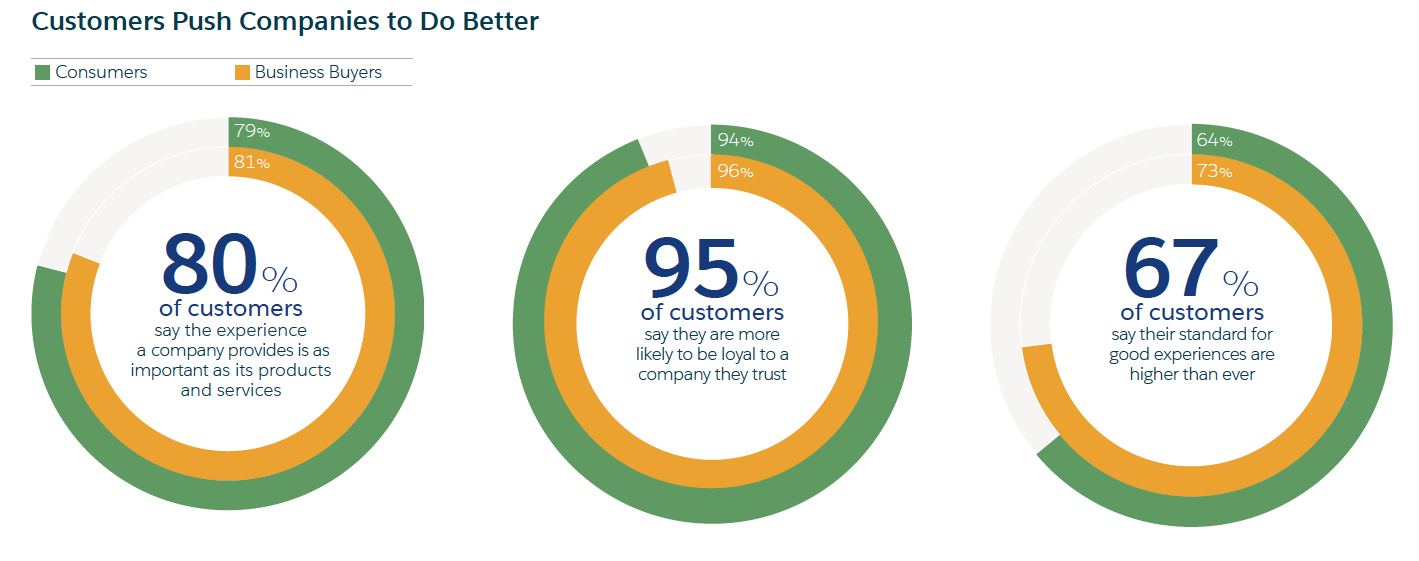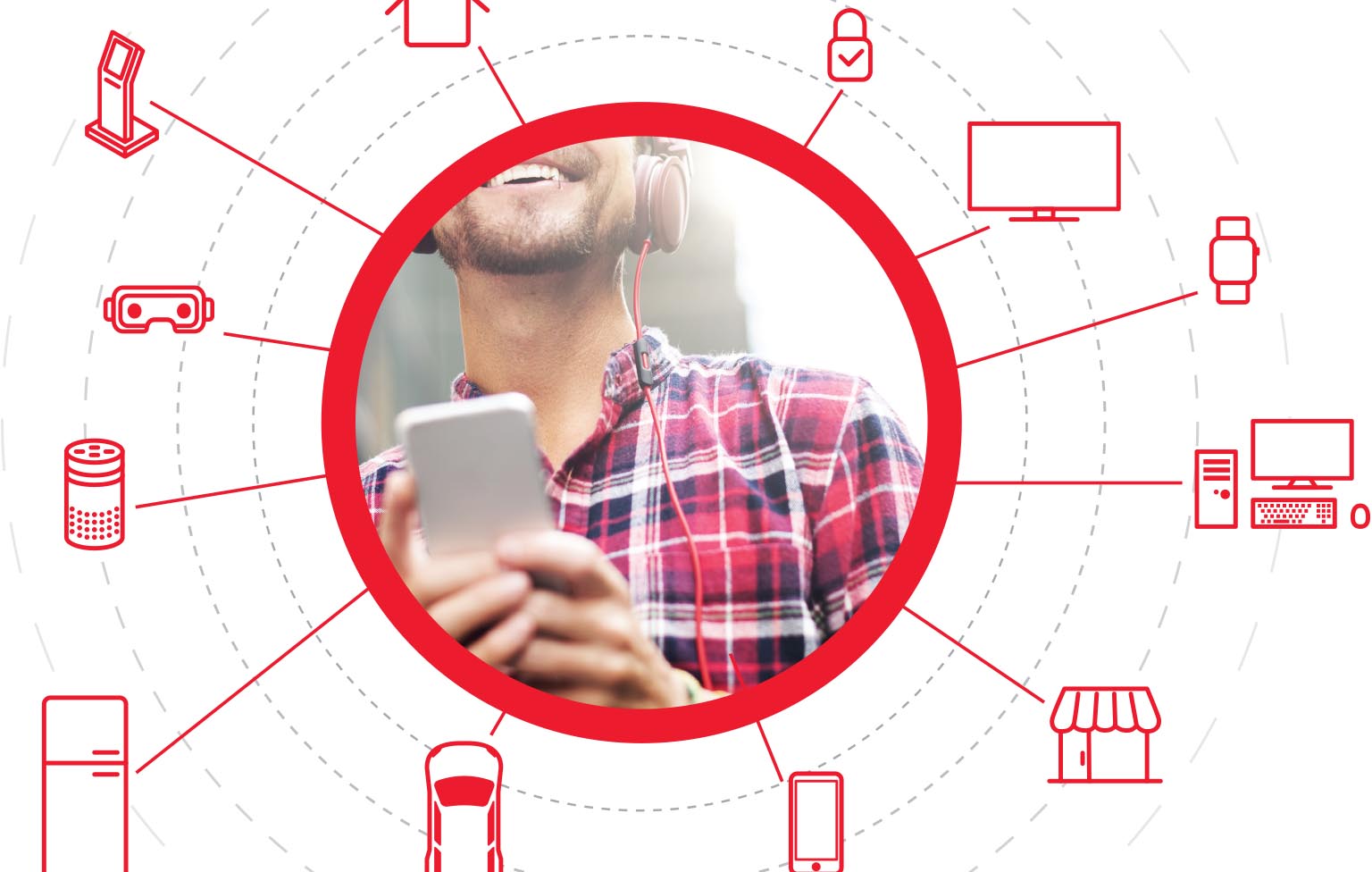Published by
If you live and work in the technology space in Dallas, I’m guessing you might have heard of Bottle Rocket. But I’ll also wager a guess that you might not really know us. Officially born in 2008, the day after Steve Jobs opened the iPhone to third-party developers, we quickly became a leader in the world of mobile application development. Eleven years later, just as the industry has continued to evolve at a mind-numbing pace, so has Bottle Rocket. And if you are still looking for the Bottle Rocket you might have once met, you may not even recognize us.
Today, more than ever, customers are in control. And digitally enabled experiences have created a new normal for all industries. Digital technology is a double-edged sword… the threat of potential disruption by competitors is only slightly as scary as the need to spark innovation to create a path for your company’s future. It’s no secret that digital native companies have generated 80% of the growth in market capitalization in the last 10 years (source: World Economic Forum, September 2018). Change is hard. But it’s only going to get harder. And that’s where our deep understanding of the Connected Lifestyle can help.
At Bottle Rocket, we are in the business of transformation. As experts at the intersection of people and technology, we create powerful, preeminent connected experiences that enable today’s Connected Lifestyle. What exactly do we mean by that? Let’s ask our own Founder and CEO, Calvin Carter.
So Calvin, how do you define the Connected Lifestyle?
If you look back at the last decade, it was about apps, new devices and form factors and new uses for mobile technology such as mobile OS’s being used for wearables or streaming players like Apple TV and Android TV. This impacted how we did everything. It was an important foundational time for us and our industry, but it’s over now.
The word “mobile” has failed us. Yes, it’s true, much of what we build is based on technology born from the mobile revolution, but the world has gotten much more complicated than that. So, a couple of years ago I started trying to define a new word to replace mobile. One that better described the new complexity and multi-platform, multi-experience, multi-use, multi-skilled and multi-everything reality in front of us. I couldn’t find one word, but I found two “Connected Lifestyle.”
The Connected Lifestyle is an ecosystem. It’s the way you deposit your checks. The way you get reservations at a restaurant, get a ride to the airport, board your plane, communicate with your colleagues and family, get a hotel room, track your health, manage your finances, teach your children and buy stuff. It’s no longer a collection of a few devices that I use for specific things. This is now an ecosystem with a full spectrum of devices, technologies and interactions that include smartphones, tablets, computers, in-home streaming players, voice assistants, bots, and even headier stuff like AR and VR experiences, AI and ML. All of it together, whether it’s your phone, watch, car or house. Everything you see in front of you every day is the Connected Lifestyle.
And, it’s where your customers and employees live right now!
And it’s complicated. Very complicated. I often say that it’s easy to make things hard and hard to make things easy. We’re in the business of ideating, designing, building and evolving preeminent experiences that are dead simple to use. Dead simple. Simple drives enjoyment. Enjoying drives engagement. Engagement drives revenue.
This is our new normal. We don’t come back from this.

( Source: “State of the Connected Customer” Salesforce Research June 2018 )
Does this mean a company has to invest in all of these technologies to be relevant?
Absolutely not. In fact, that would be a mistake. For each brand, there is a set of highly valuable experiences that you must make frictionless and dead simple. You start there, then determine which technologies make sense. Do not start with technology or you’ll just get technology. Start with experience and back into the best technologies for the job.
What are the factors causing companies to start investing in Digital Transformation and the Connected Lifestyle?
It’s different for the early adopters, the wait-and-see and the wait-and-dies in each industry. For example, some quick-serve restaurants jumped in early to experiment, then later invested big time to get way out ahead and benefitted greatly from this move. Like Chick-fil-A, who reduced wait times and line abandonment while increasing average basket size with mobile orders. They also reduced transaction fees with mobile ordering and increased repeat visits, daypart usage, and overall engagement with mobile loyalty. All of this was made possible by their iOS and Android apps that we had the great honor to build alongside them.
In every disruption, there are winners and losers. The early adopters moved and proved there is an ROI. The “wait and see’s” are following in mass right now in almost every industry. Unfortunately, the wait and die’s will likely do just that. But the reason I think there has been such as big uptick in investments in Digital Transformation and the Connected Lifestyle is 1) it’s no longer an experiment, it’s the new normal, and 2) C-suite executives are users too and they now have personal experiences as they entered the Connected Lifestyle themselves.
People don’t compare their banking experience to another banking experience. They compare it to every other super amazing digital experience that they use on a daily basis. Like their Starbucks, Uber, Hotel Tonight, Open Table and Slack experiences. C-suite execs are waking up realizing how hard it is for connected consumers to do business with their own company. If you can’t engage a brand through YOUR Connected Lifestyle, that brand is immediately less relevant to you.
Your transformation must be customer-centric. And the customer has changed.
What do you mean the customer has changed?
It’s now the Connected Customer, which is a digital native who uses technology regularly to meet wants and needs. A Connected Customer wants to make a connection with a brand but prefers the convenience and utility of a digital interaction.
And I don’t mean just young customers. Take a look at this study from Salesforce Research. Sure, Millennials are off the charts on the Connected Lifestyle gauge. But look at the Baby Boomers. Nearly half also demand a cutting-edge digital experience to keep their business and prefer innovative companies over the rest of the competitive set.
Let’s not underestimate the sheer power of these numbers. Put simply, no matter what age range you target, the vast majority of your customers have a completely new expectation from you. You can meet them where they are or lose them.

(Source: “State of the Connected Customer” Salesforce Research June 2018)
When serving the Connected Customer, it’s important to put them at the center of all of your thinking. Here are three key questions that must be answered to create value for them:
1. Where is the friction to doing business with us?
2. What would need to happen to make that go away? What context do we know that we can leverage to make this experience more valuable for the customer?
3. What do we know about the customer, so we can make this experience more personalized?
But to answer this, you can’t answer the questions yourself. You have to talk to your customers. It’s a scary thing to do if you’ve never done it. But once you do, you’ll never design anything in your business again without it. I don’t mean a Net Promoter Score or customer feedback survey. I mean ethnographic studies and the development of insightful user journeys that pinpoint the friction and the opportunity to provide value your competitors can’t or won’t.
When thinking about and taking action with your customers, consider these three things:
1. Practice empathy and realize everything is an experience for your customer. Design every product, process and interaction in service of your customer. This is table stakes. Most companies think they know their customer, but when stress tested, the truth comes out.
2. Don’t assume you understand them or their loyalty to you. Loyalty is abandoned in one click or tap, and everyone is looking for the best deal. Earn it daily through lifestyle experiences and engagement.
3. Understand how technology has changed the way they behave. Get out and talk to your Connected Customers to understand what “easy and helpful” means to them.
You’ve said the word experience a lot in this interview. Can you please explain the importance of experience for brands?
Never before has the total brand experience mattered more to consumers. In fact, 80% of both business and consumer buyers say the experience a company provides is as important as the products and services they receive through their experience with you.

(Source: “State of the Connected Customer” Salesforce Research June 2018)
And to make it even more challenging for brands, 67% of both business and consumer buyers say their standard for good experiences are higher than ever. Like I mentioned before, people don’t compare their banking experience, for example, to another banking experience. They compare it to every other super amazing digital experience that they have on a daily basis. Like their Starbucks, Uber, Hotel Tonight, Open Table, AirBnB, Venmo and Amazon experiences.
In the experience economy, the companies your customers are comparing you to has changed.
But here is the amazing news for you. If you take action, you can leverage this shift to your advantage. 57% of business and consumer buyers have moved their business because another company provided them a better experience. That could be you…
The absolute best news for you is that 67% of business and consumer buyers will pay more for a great experience. That is why brand experience is one of the highest ROI initiatives a company can start today. The returns are strong.

(Source: “State of the Connected Customer” Salesforce Research June 2018)
So, where does a CEO reading this start?
Well, like anything, it starts with insight, reflection, opportunity identification, a bold vision and relentless action.
But first, start with “why.” It’s so important to figure out the “why” behind the “what” you are going to do, or you’ll never figure out the “how.” But if you get the right “why,” you’ll figure out the how even if it seems impossible from your current vantage point.
I could write a book on the importance of “why” but Simon Sinek already wrote some great ones you should check out.
But it’s also important to figure out the “who.” Obviously every stakeholder, including the customer, is a “who,” but I’m talking about the team that is going to take action and execute your vision. This team will be made up of vendor/partners and, of course, your employees.
Here’s the three things I suggest you keep in mind when thinking about your vendor/partners:
1. Make them part of your business strategy. Transparency and authenticity are key, and many voices can help in times of chaos. Open up the “why” behind the “what” you hired them to help you with. You need requisite variety and outside voices to stay robust and relevant. If they can’t step up, then ask them to step out. The more they know about why you’re doing this and what you hope to achieve, the more value they can drive for you. Open up, include them in the conversation, not afterwards.
2. Don’t knee-jerk invest. There is new, shiny technology out every day. Go slow, think hard, reflect a lot, listen to others, then take action and invest. You can do this quickly and inexpensively if you have the right group.
3. Understand that diversity breeds strength, both internally and externally. By listening to many outside voices, you can benefit from a variety of perspectives and experiences. You will make more informed decisions and go down fewer rabbit holes. This is why public companies with boards that include a diversity of background, ethnicity, gender and outlook drive more enterprise value than those with homogenous inputs.
And, here are the three things that I suggest you keep in mind about your employees:
1. Hire and promote T-shaped people, those that have both breadth and depth. High EQ people that are a generalist in a lot of things but also an expert in one thing will produce better and longer lasting results in this new experience economy.
2. Don’t assume your team has what it needs to change with the market. The answer is simple. They don’t… Give them support, training and access to outside voices and partners who can help them cross the chasm. They must understand that things are going to change a lot, and what made them successful in the past won’t make them successful in the future. Some won’t be able to cross the chasm, but everyone deserves and authentic chance to change.
3. Understand that transformation is uncomfortable and ambiguous to your staff. Trust is the glue when logic and planning are in flux. Fill the gap with trust. You have to be upfront, honest and authentic. When we did our transformation I stood in front of the entire company and told them this was going to be hard. Some people left over it, but the net gains were clear as we attracted people who were more excited and committed than those that left.
Bottle Rocket has an unprecedented four Apple App Store Hall of fame awards to demonstrate unbelievable success in mobile. I understand no other company has won more than one, and less than 100 have ever been awarded. But what will Bottle Rocket use as measures of success in Digital Transformation and The Connected Lifestyle?
Oh boy, I could go on for an hour on this one, but allow me to answer with real-world examples. I’ll change the client names to protect the innocent.
One of our largest clients is posting 30% year over year growth in their Connected Lifestyle experiences, including native smartphone apps and mobile web. That’s a huge number, but it’s a REALLY huge number when I tell you that 70% of their revenue (multi-billion/year) comes through its websites and apps. But this isn’t easy. The business is super complicated, and there are always setbacks. But our collective teams have been able to show demonstrable value in spite of any holdups. We are truly with our client and we tear down obstacles together.
For another client, the largest product distributor in their sector, we were able to leverage our understanding of consumer behavior to disrupt how retailers manage inventory, order product, handle returns and track sell-through. Consumerization is changing everything and business buyers now act more like consumers than ever. We used this insight to produce a business tool that felt like a consumer tool. Their retail customers now report significant time savings which in turn drives more of their business to our client rather than competing distributors. Disrupt or be disrupted.
Any last minute thoughts before we wrap up?
If you only remember a few things from this time together, please remember these things:
- Simple drives enjoyment. Enjoying drives engagement. Engagement drives revenue.
- Experiences are likely the most important thing you can be investing right now.
- Consumers, both B2B buyers and B2C buyers, have forever changed how they behave. Use this as your advantage to disrupt, or be disrupted by the guy who gets there first.
- Time is of the essence. Do not wait until you have it all figured out to take action. You must be comfortable with failure and ambiguity.
- Diversity will get you the voices you need to hear to stay relevant in this age.
Finally, I’ll mention yet another Bottle Rocket client that is on the verge of really shaking up the concrete industry. This client, with a modest budget, came to us to find a completely new way to do a frequent, time-consuming, highly involved and risky task. A once manual task, with the help of connected technology, now saves money and lives by improving real-time, in-field decision making.
Thank you to Calvin for sharing his insights, wisdom, and thoughts about where Bottle Rocket and the Connected Lifestyle is headed. Stay tuned for more on this ever-changing topic.




